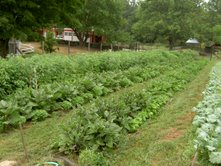Agroecosystem
A community of plants and animals interacting with their physical and chemical environments that have been modified by people to produce food, fiber, fuel, and other products for human consumption and processing.
An agroecosystem is a community of plants and animals interacting with their physical and chemical environments that have been modified by people to produce food, fiber, fuel, and other products for human consumption and processing. Agroecosystems are the basic units of study in agroecology, and they are managed to achieve specific goals, such as crop production, livestock rearing, and sustainable agriculture.
Components of Agroecosystems[edit | edit source]
Agroecosystems consist of both biotic and abiotic components:
- Biotic components: These include all living organisms within the system, such as crops, livestock, pests, pollinators, and soil microorganisms.
- Abiotic components: These include non-living elements like soil, water, climate, and nutrients.
Types of Agroecosystems[edit | edit source]
Agroecosystems can be classified into various types based on their characteristics and management practices:
- Monoculture: The cultivation of a single crop species over a large area.
- Polyculture: The cultivation of multiple crop species in the same space.
- Agroforestry: The integration of trees and shrubs into agricultural landscapes.
- Pastoralism: The raising of livestock on natural pastures.
- Aquaculture: The farming of aquatic organisms such as fish, crustaceans, and algae.
Functions of Agroecosystems[edit | edit source]
Agroecosystems perform several essential functions, including:
- Primary production: The conversion of solar energy into biomass through photosynthesis.
- Nutrient cycling: The movement and exchange of organic and inorganic matter back into the production of living matter.
- Water regulation: The control of water flow and storage within the ecosystem.
- Pest control: The management of pest populations through natural predators and other biological control methods.
Sustainability in Agroecosystems[edit | edit source]
Sustainable agroecosystems aim to balance productivity with environmental health and social equity. Key practices include:
- Crop rotation: Growing different types of crops in the same area in sequential seasons.
- Cover cropping: Planting crops that cover the soil to prevent erosion and improve soil health.
- Integrated pest management (IPM): Combining biological, cultural, physical, and chemical tools to manage pests in an environmentally and economically sound manner.
- Organic farming: Avoiding synthetic chemicals and emphasizing natural processes.
Challenges and Future Directions[edit | edit source]
Agroecosystems face several challenges, including climate change, soil degradation, water scarcity, and biodiversity loss. Future directions for research and practice include:
- Developing climate-resilient crops.
- Enhancing soil health through regenerative practices.
- Improving water use efficiency.
- Promoting agrobiodiversity to enhance ecosystem services.
See also[edit | edit source]
References[edit | edit source]
External links[edit | edit source]
This article is a agriculture stub. You can help WikiMD by expanding it!
Search WikiMD
Ad.Tired of being Overweight? Try W8MD's physician weight loss program.
Semaglutide (Ozempic / Wegovy and Tirzepatide (Mounjaro / Zepbound) available.
Advertise on WikiMD
|
WikiMD's Wellness Encyclopedia |
| Let Food Be Thy Medicine Medicine Thy Food - Hippocrates |
Translate this page: - East Asian
中文,
日本,
한국어,
South Asian
हिन्दी,
தமிழ்,
తెలుగు,
Urdu,
ಕನ್ನಡ,
Southeast Asian
Indonesian,
Vietnamese,
Thai,
မြန်မာဘာသာ,
বাংলা
European
español,
Deutsch,
français,
Greek,
português do Brasil,
polski,
română,
русский,
Nederlands,
norsk,
svenska,
suomi,
Italian
Middle Eastern & African
عربى,
Turkish,
Persian,
Hebrew,
Afrikaans,
isiZulu,
Kiswahili,
Other
Bulgarian,
Hungarian,
Czech,
Swedish,
മലയാളം,
मराठी,
ਪੰਜਾਬੀ,
ગુજરાતી,
Portuguese,
Ukrainian
Medical Disclaimer: WikiMD is not a substitute for professional medical advice. The information on WikiMD is provided as an information resource only, may be incorrect, outdated or misleading, and is not to be used or relied on for any diagnostic or treatment purposes. Please consult your health care provider before making any healthcare decisions or for guidance about a specific medical condition. WikiMD expressly disclaims responsibility, and shall have no liability, for any damages, loss, injury, or liability whatsoever suffered as a result of your reliance on the information contained in this site. By visiting this site you agree to the foregoing terms and conditions, which may from time to time be changed or supplemented by WikiMD. If you do not agree to the foregoing terms and conditions, you should not enter or use this site. See full disclaimer.
Credits:Most images are courtesy of Wikimedia commons, and templates, categories Wikipedia, licensed under CC BY SA or similar.
Contributors: Prab R. Tumpati, MD

